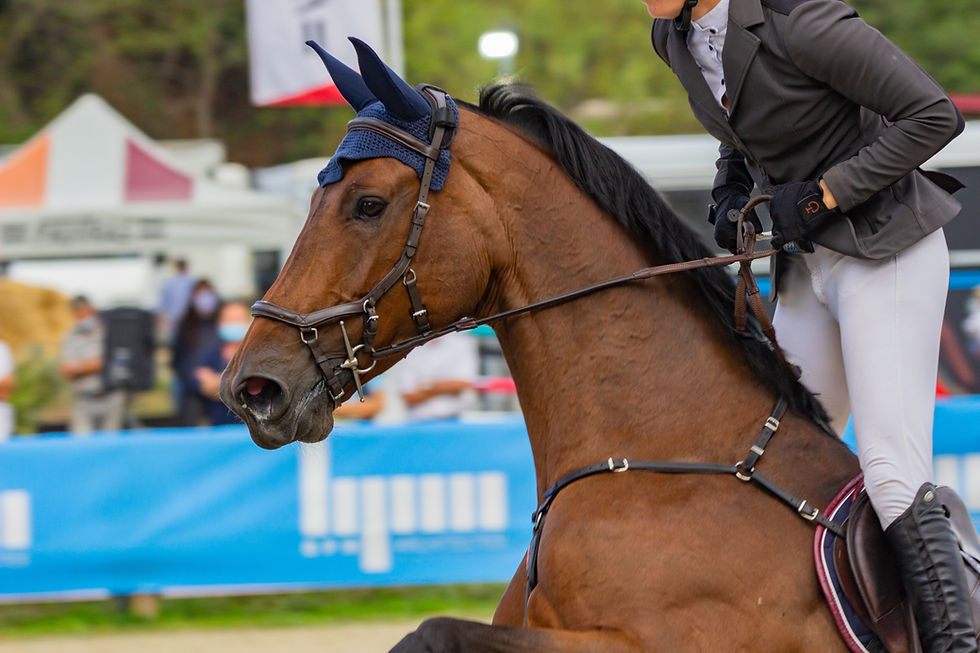HORSE BITS: THE COMPLETE GUIDE
- Pınar Horse Safari

- Jan 15, 2023
- 7 min read
WHICH BIT FOR MY HORSE? A DILEMMA ..
As you probably know, the horse bit is meant to be in the horses mouth. This allows you to guide the animal both in terms of its speed and its direction. It is extremely important to make sure that all of your horse 's hitches fit properly . An ill-fitting halter can lead to discomfort and injury, and can also lead to inappropriate behavior on the part of the horse. A horse's mouth is a very sensitive area and should therefore be handled with care. It is therefore important not only to use a bit of the right size , but also to choose the type of bit adapted to theneeds of your horse . There are so many bit options out there that it leads to a lot of confusion. We're here to try to simplify the world of the horse bit and hopefully help you solve the common dilemma " which bit for which horse "?

HOW TO MEASURE THE BIT TO GET THE RIGHT SIZE
Before you even think about changing your horse's bit , you need to be able to recognize a well-fitting bit . First of all, it should sit comfortably at the corners of the mouth and the rings should not press hard against the horse's cheek , otherwise it is too short. A bit that is too short pinches and rubs the skin at the corners of the lips and on the cheeks. If the bit is too long, there will be excess metal from the mouthpiece on either side of the lips. It could then move from side to side in the horse's mouth , especially if you pull on a rein. Bit size increasesquarter inch (0.6 cm) at a time. If your horse currently has a bit that fits but you want to buy a new one, you can simply measure the size of the current bit. Remember that you are measuring the mouthpiece and not the rings. If you don't have a well-fitting bit to compare, you need to measure your horse's mouth . Simply take a piece of string and tie a knot in one end. Pass the string through your horse's mouth, with the string resting on the outside of the lips on one side. On the other side, mark on the string with a pen or tape where it meets the outside of the lips. The distance between the knot and the mark will correspond to the size of the bitwhich you need.
CHOOSE THE THICKNESS
To start, you have to consider the thickness. The thinner the mouthpiece, the more your horse will feel the effects of the pressure of the reins. Thinner mouthpieces should promote greater contact response. Thicker bits are often a good option for young horses or horses with sensitive mouths , as they may find the pressure from a thin bit too strong. You need to consider the size of the horse's mouth , as it may not be appropriate to put a very thick bit on a small pony.
CHOOSE THE MOUTHPIECE
Straight bit - an example is the Shires Flexible Rubber Mouth Snaffle. This is a very soft bit - perfect for a young horse. This is a great bit to use for indoor shows. It is generally inexpensive.
Single Joint Bit - This is a very common mouthpiece. The articulation of the Korsteel JP stainless steel hinged mouthpiece allows the rider to apply pressure to one side of the mouth more than the other. It can, however, have a nutcracker effect. When the bit moves, the joint moves up and down. It can collide with the palate or tongue, causing discomfort. This can be a particular problem for a horse that has little room between its tongue and palate.
Double Jointed Bits - These bits are also split into different sections as above, but have an extra piece between the two halves. It can take different shapes, such as a French link (which is flat) or a diamond (a rounded piece). They are comfortable for many horses as they reduce the nutcracker effect. However, not all horses are the same and some don't like the tongue pressure that comes with the extra bond.
Roller bits - Some bits have rollers on the mouthpiece. They are rotating parts and the horse can move using its tongue. The idea is to encourage the horse to put itself in the mouth and to play with the bit. This helps him relax in the mouth and jaw and hopefully accept the bit better.
Waterford Bit - A Waterford bit has multiple joints and links that look like a chain. The entire mouthpiece is movable and therefore encourages the horse to play with the links in its mouth. As a result, the Korsteel Waterford Loose Ring Snaffledoing is generally more flexible on the reins and prevents them from bending or pulling. Because the Waterford prevents the horse from clinging to the bit with its tongue and teeth, it cannot lean on the bit when the joints sag and move. This is why the Waterford is a relatively strong and stern bit for a horse - so it is best used for those very strong horses. The bit also encourages the horse to relax and loosen the jaw.
CHOOSE THE RIGHT BIT RING
Watch out, even more choices to come! We will again try to introduce you to some of the most common designs of rings. We are not going to talk about all the existing bits but about those that you will come across the most. This little comparison will help you choose.
Chantilly bit - The rings can rotate around the hole in which they are attached to the mouthpiece. This allows the mouthpiece to be independent of rein contact in that it can move with the horse's tongue and jaw. This bit makes it difficult for the horse to lean on the bit or grab it. It is very important that it fits correctly, because if it is too small when the ring rotates, it will pinch the horse's skin. It may also be possible to pull this bit through the mouth if pulling on a rein, as the rings don't offer much resistance to side-to-side movement.
Curved jaw - this is a fixed ring option that provides consistency in the mouth. If you pull on a rein, the bit is less likely to move from side to side of the mouth than with the loose ring. The mouthpiece is less able to follow the movements of the horse's mouth and is more dependent on the movements of the rein contact. Some horses may prefer this consistency, while others may find it more constricting and unnatural. A fixed ring is not the best option for horses that tend to lean on the bit.
Needle bit - This can be a good option for a young horse or an inexperienced horse. Bars protruding from the cheek help direct the head and turn. When turning, the pressure of the reins is applied to one side of the bit more than the other. The bars on the opposite side will press down on the cheek and encourage the horse to turn with its head. This is useful for horses that need to learn to react to turning aids or for those trying to tilt their head to avoid rein pressure. The bars also prevent the bit from being pulled through the mouth and are more effective for this purpose than a hoof kick.
Baucher bit - This type of bit exerts a small amount of probing pressure allowing the rider to more easily command the horse to bend and soft in the head. However, because this bit stays in a fixed position, it can improve communication between the horse and the rider's hands.
Mors pessoa - There are different styles of gags, the Dutch gag being one of the most popular. A gag is a means of pressure which makes it possible to put pressure on the survey. You can simply choose the leverage by the different rings on the bit. Some gags have two rings and others have three. The lower the ring you choose, the more leverage you get and therefore more pressure. You must use either two reins or a rounded one with this type of bit.
3 Ring Bits - We recommend using these bits for more experienced riders looking for a bit more control when riding. A 3-ring bit is an excellent bit to encourage the horse to improve its head posture. By adding light pressure to the poll, he encourages the horse to lower his head. With the lower loop of the bit, he adds light pressure on the tongue to again encourage the horse to soften his head in the bit.
3-Effect Bit - A bevel (also called a "Wilkie") is a way to gently add probing pressure to encourage the horse to ease into the reins , lower its carriage head, and make contact with the bit . The bevel provides more stopping power and is therefore ideal for horses that need something slightly stronger than a bit. It is an excellent bit for a novice horse during a competition!
Lifter bit - this bit is ideal for horses that are strong, difficult to control and heavy in the hand. It is designed to work on the horse's lips to encourage them to raise their head slightly, reducing pressure and pressure on the bit. A Cheltham Gag requires double reins. A training aid and answer for experienced riders who have a strong horse. The first set of reins attaches to the cheek strap and passes through the bit. The second pair attaches directly to the bit.
CHOICE OF MATERIAL
You will see bits made from many different materials. So here is our guide to help you choose which one might be right for your horse.
Stainless Steel - This is the most common material that drill bits are made from. These wicks do not rust and therefore have a fairly neutral taste. Many horses are happy to use a stainless steel bit. However, each horse accepts bits differently!
Copper/Brass - When your horse's saliva reacts with copper, it causes the metal to rust. This is actually a good thing because it gives a sweet taste. Some horses also like the fact that this bit is a bit warmer in their mouth than a steel bit. Brass bits are alloyed with copper to produce a strong, durable metal.
Soft Iron - These bits rust on contact with your horse's saliva. This creates a sweet taste which should encourage them to produce more saliva and mouth on the bit. Most horses enjoy the taste of this bit. Don't worry if it starts to change color, it's rust.
Plastic/Nylon/Rubber - These light but strong coatings are normally found on stainless steel end caps. They are good for horses that don't like the cold feeling of metal in their mouth. Some of these bits have an apple flavor to encourage mouthing and salivation. If you have a horse that chews its bit a lot, it can become deformed and the teeth marks can make the surface rough.
Did you visit Campervan Turkey?







Comments